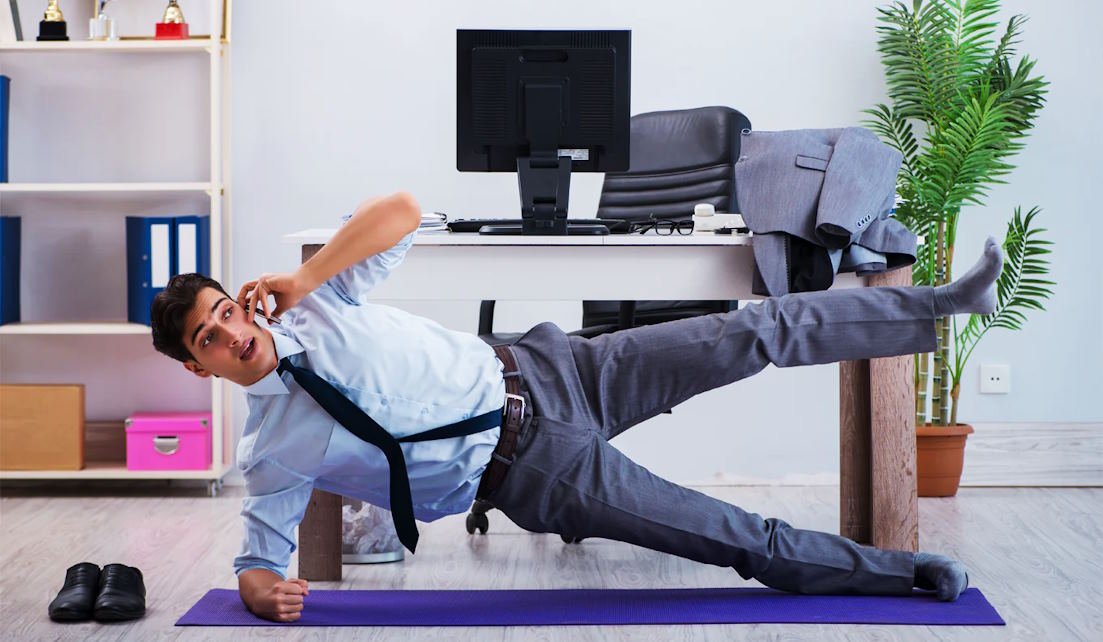In the contemporary landscape of professional life, the majority of individuals find themselves tethered to desks, engaged in sedentary activities that can take a toll on both physical health and overall well-being. As our workspaces become increasingly digital and our tasks more computer-centric, the transition from the gym to the office has never been more challenging. The sedentary nature of office jobs raises concerns about the detrimental effects of prolonged sitting, leading to issues such as poor posture, increased stress levels, and a range of health problems.
Incorporating Physical Activity into the Workday
Desk Exercises and Stretches
- Simple Desk Exercises:
Sitting at a desk doesn’t mean sacrificing physical activity. Incorporate discreet yet effective exercises into your work routine. Try seated leg lifts, desk push-ups, or isometric exercises like engaging your core while sitting.
- Stretching Routines to Alleviate Stiffness:
Combat the stiffness that often accompanies desk-bound hours with targeted stretching. Incorporate neck stretches, shoulder rolls, and seated spinal twists to release tension. These quick stretches enhance flexibility, reduce muscle tightness, and promote better circulation, leaving you feeling rejuvenated and ready to tackle your next task.

Taking Advantage of Breaks
- Short Walks and Movement During Breaks:
Breaks are not just for scrolling through your phone. Use these intervals to take brisk walks, whether around the office or outdoors. A 10-minute stroll can do wonders for your energy levels and mental clarity. Additionally, perform light stretches during breaks to prevent muscle stiffness and enhance overall mobility.
- Importance of Stepping Away from the Desk:
Resist the temptation to stay glued to your desk during breaks. Physically stepping away not only provides a mental breather but also allows your eyes to rest from screen exposure. Whether it’s a stroll to the break room or a brief outdoor excursion, these moments away from the desk contribute significantly to your overall well-being, helping you return to work with renewed focus and vitality.
Desk Ergonomics and Active Workstations
Importance of Proper Desk Setup for Posture and Health:
Your desk setup plays a pivotal role in shaping your posture and, consequently, your overall health. A poorly configured workstation can contribute to discomfort, musculoskeletal issues, and reduced productivity. Prioritize an ergonomic arrangement, ensuring your monitor is at eye level, your chair supports the natural curve of your spine, and your keyboard and mouse are within easy reach. This attention to detail not only promotes a comfortable work environment but also safeguards your long-term well-being.

Introduction to Standing Desks and Their Benefits:
Embracing the concept of standing desks introduces a transformative shift in the sedentary office culture. These adjustable desks empower you to switch between sitting and standing positions throughout the day. The benefits are manifold – from improved circulation and reduced back pain to increased energy levels. Standing desks foster a dynamic work environment, encouraging movement and mitigating the adverse effects of prolonged sitting.
Alternatives like Stability Balls and Active Sitting Options:
Ditch the conventional chair and explore alternatives like stability balls and active sitting options. These alternatives engage your core muscles, promoting better posture and balance. Stability balls, in particular, encourage subtle movements to maintain stability, enhancing both physical activity and concentration. Active sitting options, such as ergonomic chairs with dynamic features, provide a comfortable yet active seating solution, making your workstation a hub for both productivity and physical well-being. Experimenting with these alternatives can revolutionize your work setup, transforming it into a space that nurtures both your body and productivity.










